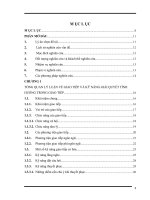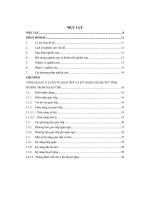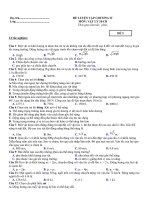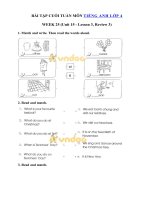ĐỀ LUYỆN TẬP THÌ GIỮ HỌC KÌ 2 MÔM TIẾNG ANH 11 GLOBAL SUCCESS
Bạn đang xem bản rút gọn của tài liệu. Xem và tải ngay bản đầy đủ của tài liệu tại đây (123.02 KB, 4 trang )
PRACTICE TEST 9
CLASS.11...............................
NAME....................................
Choose the word with different pronunciation of the underlined part .
(<1>) A. culture
B. student
C. institution
D. university
(<2>) .A. parks
B. animals
C. planets
D. environments
Mark the letter A, B, C, or D to indicate the word that differs from the rest in the position of the main
stress in each of the following questions.
(<3>) A. A.absorb
B. delay
C. concern
D. impact
(<4>) A. awareness
B. emission
C. infectious
D. chemical
Choose the word or phrase (A, B, C, or D) that best fits each space in the following passage.
The World Health Organization (WHO) is warning young people all over the world that they are also at risk
from COVID-19. The WHO said young people are not exempt from catching the coronavirus. Many young
people ([<5>])………….….believe they will not catch the virus because of their age. They think it is a
disease that only older people catch. The WHO said the truth is ([<6>])………….… young people are
catching the coronavirus and becoming ill or dying from it. It added that young people are also spreading the
disease to their parents, grandparents and ([<7>])……………….people. The White House also urged young
adults to follow advice and to avoid gathering in large groups to help prevent the spread of the virus.
The Director-General of the WHO said: "Today, I have a message for young people: You are not
invincible." He added: "This coronavirus could put you in hospital for weeks, or even kill you. Even if you
don't get sick, the choices you make about where you go could be the difference between life and death for
someone else." The WHO said: "A significant proportion of patients([<8>])……………… in hospital for
COVID-19 around the world are aged under 50." New York Governor Andrew Cuomo said many young
people are not ([<9>])…………..…the state's social-distancing rules. He told young people that: "This is a
public health issue and you cannot be endangering other peoples' health."
( Source: />(<5>) A.really
B. mistakenly
C.strongly
D. frequently
(<6>) A.why
B. what
C. that
D. when
(<7>) A. other
B.others
C.the others
D. the other
(<8>) A.to treat
B.to be treated
C.treating
D. treated
(<9>) A. following
B. doing
C.making
D. keeping
Choose the word or phrase (A, B, C, or D) that best fits the blank space in each sentence from {<1>} to
{<15>}.
(<10>) Women have to do hard work nowadays as they used to,
?
A. are they
B. aren’t they
C. do they
D. don’t they
(<11>) After
, people feel more refreshed and alert.
A. meditation
B. attention
C. determination
D. prescription
(<12>) We haven’t reached the final
on the funding for scientific research yet.
A. decides
B. decision
C. deciding
D. decisive
(<13>) A He is exhausted. He
around the whole afternoon trying to clean the house before the guests
arrive.
A. has been runningB. has run
C. be running
D. was running
(<14>) Please help me with this math problem. I can’t
the answer.
A. end up
B. face up to
C. come up with
D. run into
(<15>) The conductor asked
in the bus.
A. them to please not to smoke
B. that they should not smoke
C. them not to smoke
D. them not to smoke
(<16>) Global warming will result
crop failures and famines.
A. with
B. from
C. for
D. in
(<17>)
, Peter came to see me.
A. While having dinner
B. While I was having dinner
C. When having dinner
D. When I am having dinner
(<18>) Have you visited the pagodas
on Tran Phu Street in Hoi An.
A. to lie
B. lying
C. lain
D. lie
(<19>) In the USA, a public school is a state school,
is run by the government and is free to attend.
A. that
B. which
C. who
D. Ø
(<20>)
trees around the house on the south and west sides, they van save up to about $250 a year on
cooling and heating.
A. to plant
B. to have planted
C. having planted
D. for having planted
(<21>) If you go by air, it ____ you around two hours to get to Ho Chi Minh City from Ha Noi.
A. would take
B. takes
C. took
D. spends
(<22>) The only structure to remain
is the flag tower of Ha Noi built in 1812 during the Nguyen
dynasty.
A. original
B. intact
C. initiative
D. royal
(<23>) Trang An Scenic Landscape Complex is
to many temples, pagodas, and places of worship.
A. house
B. site
C. home
D. place
(<24>) By cutting down trees we ____ the natural habitat of birds and animals.
A. hurt
B. harm
C. damage
D. injure
Choose the underlined part among A, B, C or D that needs correcting from {<1>} to {<3>}.
(<25>) Having cutting down many trees in the area, now the people here have to suffer really hot summers.
A
B
C
D
(<26>) Food prices have raised so rapidly in the past few months that some families have been forced to alter
their eating habits.
A
B
C
D
(<27>) The doctor advise him not to exercise too hard because it was not good for his heart.
A
B
C
D
Mark the letter A, B, C, or D on your answer sheet to indicate the word or phrase that is OPPOSITE in
meaning to the underlined part in each of the following questions from {<1>} to {<2>}.
(<28>) If I take the pessimistic viewpoint, Tokyo won't be a safe place to live in.
A. negative
B. optimistic
C. optical
D. neutral
(<29>) Tom may get into hot water when driving at full speed after drinking wine.
A. get into trouble
B. stay safe
C. fall into disuse
D. keep calm
Mark the letter A, B, C, or D on your answer sheet to indicate the word or phrase that is CLOSEST in
meaning to the underlined part in each of the following questions from {<1>} to {<2>}.
(<30>) Life expectancy for both men and women has improved greatly in the past twenty years.
A. Living standard B. Longevity
C. Life skills
D. Lifeline
(<31>) The United Nations Educational, Scientific and Cultural Organization (UNESCO), was established in
1946.
A. set up
B. found out
C. run through
D. put away .
Mark the letter A, B, C, or D on your answer sheet to indicate the most suitable response to complete
each of the following exchanges .
(<32>) “Why do you choose French as your second major?” – “__
__”
A. Because it's quite like English.
B. Because they are friendly.
C. I don't really care.
D. It's nice to say so.
(<33>) Alice and Mary are talking about women’s roles.
- Alice: In my opinion, women should go to work to share household financial burden with their husband.
- Mary: ______
___.
A. That’s a good idea. Women are good at raising children
B. I can’t agree with you more.
C. I like going to work.
D. No, I don’t think so. Many of them are successful businesswomen
Read the passage carefully and choose the best answers .
Many people see large urban cities as a wonder of human imagination and creativity. They represent
how far the human population has come in terms of community development. Many positive things come
from urbanization, but there are also negatives. This article will discuss and present data on the implications
of urbanization on the physical health of humans living in these large urban areas.
As it would be expected, developing countries tend to see more negative physical health effects than
modern countries in regard to urbanization. One example of a developing country experiencing these
problems is China. China is a country that in the past 30–40 years went from being an agrarian based
society to a significant industrialized country. This industrialization has in effect caused the need for more
centralized cities, centralized meaning having lots of jobs and living spaces within a close proximity. This is
what is known as urbanization. In most recent decades, since China’s change to being more of an industrial
based economy, the country has experienced record high numbers of people migrating within its borders. In
effect, the number of cities with over 500,000 people has more than doubled. These migrations are typically
of people from rural areas of China moving to the new urban areas. Due to this large influx in the urban
population, there are many possibilities for health challenges among these people.
One very common and fairly obvious negative aspect of highly congested urban areas is air
pollution. Air pollution is defined as any harmful substance being suspended in the air. This could include
particulate matter, most commonly attributed to industrial plants and refineries waste, or chemicals like CO2
or Methane (which are also products of plants and refineries as well as cars and other modes of
transportation). Due to a vast number of people in these urbanized cities, the air pollution is known to be
very extreme. These conditions can lead to many different health problems such as: Asthma, cardiovascular
problems or disease, and different types of cancer (most commonly lung cancer). When exposed to these
conditions for a prolonged period of time, one can experience even more detrimental health effects like: the
acceleration of aging, loss of lung capacity and health, being more susceptible to respiratory diseases, and a
shortened life span.
Another way that urbanization affects the populations’ health is people’s change in diet. For instance, urban
cities tend to have lots of accessible, quick, and easy to get food. This food is also more than likely not as
high quality as well as contains a large amount of sodium and sugar. Because this food is so accessible,
people tend to eat it more. This increase in consumption of low quality food can then lead to diabetes,
hypertension, heart disease, obesity, or many other health conditions.
(Adapted from )
(34>) . Which of the following could be served as the best title for the passage?
A. Urbanization – Pros and cons
B. Urbanization – How people’s health is impacted?
C. Urban cities – The new opportunity for community development
D. Developing countries – The fastest urbanization
(<35>) What does the phrase “these problems” in paragraph 2 refer to?
A. industrialized countries
B. lots of jobs and living spaces
C. immigrants
D. negative physical health effects
(<36>) . According to paragraph 2, which of the following is TRUE about China?
A. This is a developed country in the past 30-40 years.
B. The population of cities now more than doubles that in the past.
C. Most of the new urban areas’ populations are the emigrants from remote places.
D. Because of urbanization, more immigrants find their ways to this country.
(<37>) The word “congested” in paragraph 3 is closest in meaning to ___________.
A. overcrowded
B. sparse
C. contaminated
D. fresh
(<38>) . The following are the air pollution sources mentioned in paragraph 3, EXCEPT ________.
A. industrial factories
B. refineries waste
C. chemicals
D. sewage
(<39>) . Why are urban populations easy to get diseases from food, according to the last paragraph?
A. Because of the low quality and the high proportion of sodium and sugar in this food.
B. Because the way people get this food is rather accessible, quick and easy.
C. Because this food is so delicious that people have a tendency to eat more than normal.
D. Because of the change in people’s diet.
(<40>) What can be inferred from the passage?
A. Living in urban areas for a long time will not make the life expectancy of inhabitants shorten.
B. One of the negative health effects comes from the overpopulation in industrialized countries.
C. People in developed countries suffer less harmful health effects from urbanization than those in
developing nations.
D. The bad health effects from urbanization are not greater than the benefits it brings to people in urban
cities.
Read the following passage and mark the letter A, B, C, or D on your answer sheet to indicate the correct
answer to each of the questions.
The generation gap that was so in evidence during the 60s has resurfaced, but it is not the disruptive force
that it was during the Vietnam era, a 2009 study suggests. The Pew Research Center study found that 79% of
Americans see major differences between younger and older adults in the way they look at the world. In
1969, a Gallup Poll found that a smaller percentage, 74%, perceived major differences.
Today, however, although more Americans see generational differences, most do not see them as
divisive. That is partly because of the areas of difference. The top areas of disagreement between young and
old, according to the Pew Research Study, are the use of technology and taste in music. Grandparents are
likely to have observed these differences in their grandchildren who are tweens, teens, and young adults.
If large differences between the generations exist, why don't they spawn conflict? The answer is twofold.
First, the two largest areas of difference—technology and music—are less emotionally charged than
political issues. The older generation is likely to be proud of the younger generation's prowess in technology
rather than to view it as a problem. As for the musical differences, each generation wants its own style of
music, and the older generation generally can relate to that desire.
Second, in the other areas of difference, the younger generation tends to regard the older generation as
superior to their own generation—clearly a difference from the 1960s with its rallying cry of "Don't trust
anyone over thirty." According to the Pew study, all generations regard older Americans as superior in moral
values, work ethic and respect for others.
(Adapted from www.verywellfamily.com
41. Which of the following could be the main idea of the passage?
A. Generation gap doesn’t cause a big problem in American families.
B. Different points of view are the main problem between generations in America.
C. The generation gap in the past was different from that in modern time.
D. The areas of differences in generation gap have changed over the years.
42.The word “divisive” in the second paragraph is closest in meaning to _________.
A. agreeing
B. positive
C. serious
D. discordant
43.What are the two reasons why large differences between generations don’t cause disagreement?
A. The generosity of the elder generation and the attitude of the younger generation.
B. The different styles of music and the knowledge of the elder generation.
C. The major aspects of differences between generations and the respect to the elder generation.
D. The pride of the elder generation and the obedience of the younger one
44.The word “their” in the last paragraph refers to __________.
A. the older generation’s
B. the younger generation’s
C. supervisor’s
D. over-thirty people’s
45.According to the passage, which is NOT true?
A. The majority of Americans agree generations’ viewpoint to be the major differences.
B. Technology is one of the two biggest areas creating the gap between the old and the young.
C. Grandparents feel uncomfortable with their grandchildren because of their better technology skills.
D. The elderly in America are admired in moral values, work ethic and respect for others.
Mark the letter A, B, C or D to indicate the sentence that is closest in meaning to each of the following
questions.
46.I haven't heard from him for ages.
A. I didn't write to him for ages.
B. I last wrote to him long time ago.
C. I wrote to him for ages.
D. I haven't written to him long time ago.
47.“Mum, please don’t tell Dad my mistake!” the boy said.
A. The boy insisted his mother not tell his father his mistake.
B. The boy told his mother not to mention his mistake any more.
C. The boy asked his mother not to tell his father his mistake.
D. The boy wanted his mother to keep his mistake in her heart.
48.You are able to go out with your friend this evening
A. You musn’t go out with your friend this evening. B. You should go out with your friend this evening.
C. You needn’t go out with your friend this evening. D. You can go out with your friend this evening.
Mark the letter A, B, C or D to indicate the sentence that best combines each pair of sentences in the
following questions.
49. He is short-sighted. Therefore, he has to wear the glasses.
A. If he isn’t short-sighted, he won’t have to wear the glasses.
B. If he hadn’t been short-sighted, he wouldn’t have had to wear the glasses,
C. If he weren’t short-sighted, he wouldn’t have to wear the glasses.
D. Should he not be short-sighted, he won’t have to wear the glasses.
50. Right after the boy got out of his house, it started to rain heavily.
A. It had rained heavily before the boy got out of his house.
B. No sooner had the boy got out of his house than it started to rain heavily.
C. Not until it started to rain heavily did the boy got out of his house.
D. it was not until it started to rain heavily did the boy get out of his house
THE END









